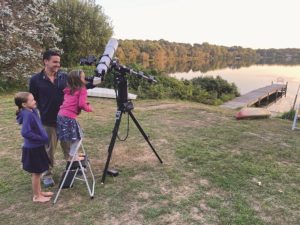You can always spot an amateur astronomer. When we step outside after sunset, we’re the ones who pause, look up, and turn slowly. We’re finding the Moon, noting its phase and position, and picking out a few prominent guide stars or constellations — the Big Dipper, Arcturus, or maybe Orion in winter. We’re in the habit of getting oriented in time, space, and season.
One of the simpler pleasures of astronomy is knowing the night sky. Learning your way around it is not unlike learning to map your surroundings down here on the ground. There are many landmarks to guide you. I’m sure that if you were blindfolded, spun in circles, and placed somewhere on the Outer Cape, you would quickly figure out where you were. Is that the bay or ocean? Jeremy Point? The West End?

You need only one or two celestial markers to begin forming a mental map of the sky. Each marker builds on the others, bridging the unfamiliar gulfs, until eventually the entire night sky is as familiar to you as your native ground. Two I’ve written about here before are the North Star and the Summer Triangle.
Medieval mapmakers illustrated unknown areas with dragons and other mythological creatures, and two important early globes, the Lenox Globe and the Da Vinci Globe, both dating from 1504, include a Latin notation, hic sunt dracones: here be dragons.
Maybe those mapmakers were right. The constellation Draco (the Dragon), unfamiliar to most people, lies between those two celestial signposts, the North Star and the Summer Triangle. Welcoming the Dragon into the fold will expand your celestial map.
Start by finding the Summer Triangle. This asterism (a pattern or shape that isn’t part of any official constellation) is overhead during these late summer nights, a little east of straight up. Look for three bright stars that form a triangle. Those are Deneb, Altair, and Vega.
Next, identify the brightest star of the three — depending on the time of night you’re out, it’s likely to be nearly directly overhead. That’s Vega. Remember the 1997 movie Contact, starring Jodie Foster? It’s one of my favorites and is likely on any amateur astronomer’s short list. Vega is the star where the signal from the extraterrestrials originated. Note its position.
Now, find the North Star. Look to the northwest and find the Big Dipper, a constellation that’s usually easy to identify. Follow the line formed by the dipper’s lip north until you reach an otherwise unremarkable, moderately bright star. That’s Polaris, the North Star.

Now you’re ready to venture into the dragon-haunted territory between Vega and Polaris. Draco is a slim but expansive constellation; imagine a long serpentine dragon from Chinese mythology, rather than the massive Smaug from The Hobbit. Draco’s head lurks close to Vega — look for two fairly bright stars very close together. Its narrow body then snakes this way and that, curving northeast, twisting around to the northwest, and finally tapering off to a sharp tail pointing north.
The third star from the end of the dragon’s tail has the official designation Alpha Draconis. It’s also called Thuban, a transliteration from Arabic meaning “big snake.” You may recall that all stars are in motion, albeit slowly, and that Polaris has not always been the North Star. When the ancient Egyptians built the Great Pyramid in 2600 BCE, Thuban occupied the position of North Star.
Draco is a somewhat obscure but fun constellation to be able to identify. To me, it seems to guard the northern reaches of the sky from celestial interlopers, while welcoming Earth-bound observers. Clear skies!



